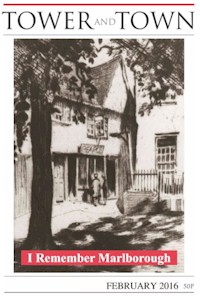

Tower and Town, February 2016 (view the full edition) (view the full edition)A Tragic Year For Mildenhall1915 was the first full year of the Great War. When war was declared on 4 August 1914 it was said that it would be all over by Christmas. This however was far from the case: a line of trenches was established on the Western Front from the North Sea to Switzerland and deadlock ensued. The challenge for the High Command was how to break this stalemate. Two policies were trialled: frontal assaults of increasing ferocity and magnitude on the Western Front, and attacks designed to knock out German allies, drawing attention away from the Western Front. The iconic battles of 1915 were the Battle of Loos in the autumn of 1915 and the campaign in Gallipoli. Mildenhall men were involved in both. The first Mildenhall man to meet his death was Lance-Corporal James Angell. James was a regular soldier with Ist Wiltshires and he went to France at the very beginning of the war with the original British Expeditionary Force. At the time of his death the battalion was manning the trenches in area of Ypres. The war diary of 5 May 1915 describes: " Short bursts of rifle fire by night. One man killed. " This man was James Angell. Another Mildenhall regular with the 1st Wilts met his death in 1915. This was Private Charles Barnett. Charles was in France within ten days of war being declared. He died on 1 September 1915 when the battalion was out of the line. This suggests he died as a result of illness or an accident as he is buried in a battlefield cemetery. With men flooding into the Army at the beginning of the war the 1st Battalion Wiltshire regiment eagerly sought recruits to replace losses. Men were given six weeks basic training before being sent to the front. A draft set to the front on 27 October 1914 included Mildenhall man Private Frank Chun. The Wiltshires were not in the main attack at the Battle of Loos but were twenty five miles to the north, attacking on the same day to hold the German defenders in their positions. As so often happened with subsidiary attacks losses could be severe. Frank was one of the casualties. His body was never recovered and he is commemorated on the Loos Memorial to the missing. His younger brother Walter was conscripted into the Army and he too was killed in 1917 at the Third Battle of Ypres. Frank Chun is not the only Mildenhall man commemorated on the Loos Memorial. Major Alfred Soames , son of the Reverend Charles Soames, former Rector at Mildenhall, was a company commander with the 6th Battalion East Kent Regiment. This was a New Army battalion of volunteers, the 'First Hundred Thousand' raised at the beginning of the war by Lord Kitchener, and went to France on 31 May 1915. New Army battalions were extensively used at the Battle of Loos with generally disastrous results. The battle commenced on 25 September and dragged on into October with no advantage to either side. The offensive recommenced on 13 October when the 6th East Kents went over the top. The battalion suffered four hundred casualties in the first few minutes. Alfred was one of the casualties and his body was never recovered. The first locally raised New Army battalion was the 5th Battalion Wiltshire Regiment. Many men from Marlborough & Mildenhall joined this battalion., which sailed from Avonmouth to Gallipoli on 31 May 1915. At least three men from Mildenhall sailed, Privates Tom Humphries, Edward Whitlock and George Wilder. The battalion made two separate landings on the Gallipoli peninsula. On 16 July they landed on 'V' beach on Cape Helles and were then withdrawn at the end of the month and put ashore at Anzac Cove. Tom Humphries was killed on 26tJuly by a sniper whilst manning the trenches at Cape Helles. The landing at Anzac Cove was to support and reinforce the Anzac forces who were storming the heights inland from the beach. The New Zealand infantry had taken the summit of a position known as Chunuk Bair but were behind schedule and exhausted. They were to be relieved by the 5th Wiltshires on 10 August. The relief took place at night under fire from Turkish positions. The Turks immediately overran the position and the Wiltshires were driven off the heights. One hundred and forty three soldiers died on 10 August. Edward Whitlock was one of the soldiers killed on this day. George Wilder survived the massacre at Chunuk Bair only to be killed in action the following year in Mesopotamia. Six men from Mildenhall were killed in action in 1915. Andrew Ross |